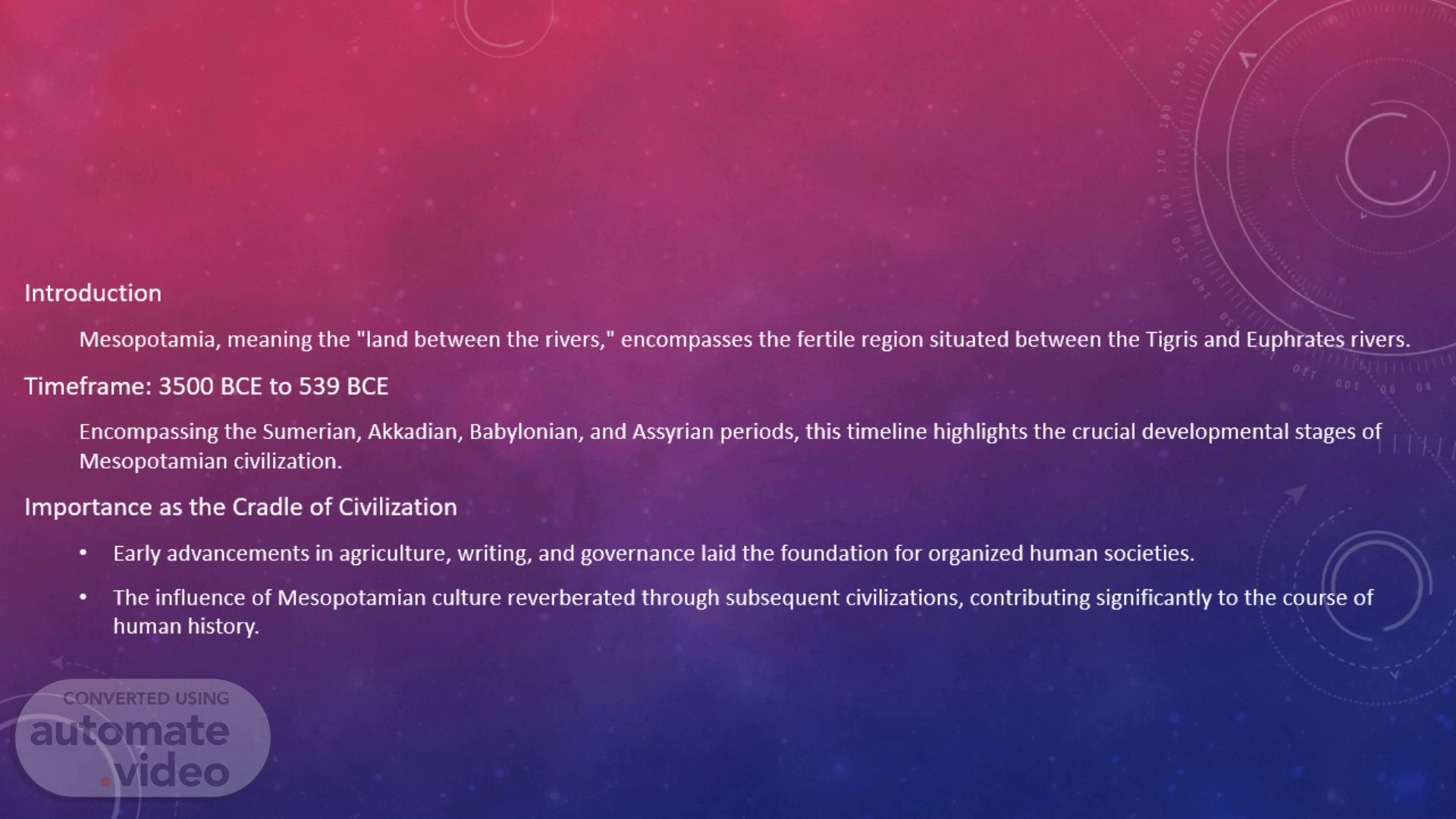
Page 1 (0s)
[Audio] Mesopotamia, often referred to as the "Land between the Rivers," encompasses the fertile region between the Tigris and Euphrates rivers. This cradle of civilization witnessed a transformative period from 3500 BCE to 539 BCE, spanning the Sumerian, Akkadian, Babylonian, and Assyrian periods. The significance of Mesopotamia lies in its early advancements in agriculture, governance, and writing, which profoundly influenced subsequent cultures and laid the groundwork for organized human societies..
Page 2 (34s)
[Audio] The Tigris and Euphrates rivers served as the lifeblood of Mesopotamian civilization, providing essential resources for agriculture and sustaining urbanization. The unpredictable flooding of these rivers led to the development of intricate irrigation systems, showcasing the adaptability of Mesopotamian societies. The Fertile Crescent, with its rich soil, allowed for surplus food production, fostering the growth of urban centers and the emergence of city-states. However, environmental challenges such as flooding and the absence of natural barriers influenced societal structures and city-state dynamics..
Page 3 (1m 14s)
[Audio] Mesopotamia's landscape was dotted with independent city-states like Ur, Uruk, and Lagash, each with its own governance and rulers, often engaging in political rivalries. Ziggurats, towering structures, served as religious monuments and administrative hubs, emphasizing the close intertwining of religious and political aspects in Mesopotamian society. The development of cuneiform writing on clay tablets marked a pivotal advancement in communication, used extensively for record-keeping, literature, and administration. Mesopotamians demonstrated achievements in astronomy with a lunar calendar and mathematics using a sexagesimal system. The arts and culture flourished with the Epic of Gilgamesh, one of the oldest known epic poems, and intricate cylinder seals and pottery showcasing their artistic prowess..
Page 4 (2m 7s)
[Audio] Mesopotamia's influence on later civilizations, particularly the Greeks and Romans, is evident in the foundational aspects of governance, writing, and science. The spread of Mesopotamian cultural elements through trade routes contributed to cultural diversity in the surrounding regions. Despite its enduring impact, Mesopotamia faced invasions and conflicts from Babylonians, Assyrians, and Persians, ultimately leading to the fall of Babylon in 539 BCE to the Persian Empire. This marked the end of Mesopotamian independence, signaling a shift in power dynamics in the region. In conclusion, Mesopotamia's enduring legacy continues to shape our understanding of early civilizations and their lasting contributions to human history..
Page 5 (2m 56s)
[Audio] As we reflect on the journey through Mesopotamia, the cradle of civilization, it becomes evident that this region played a pivotal role in shaping human history. Its enduring impact is seen in governance, writing, science, and art, influencing diverse regions and contributing to the rich tapestry of human heritage. Despite facing environmental challenges, Mesopotamia's achievements, such as advanced irrigation systems and monumental architecture, exemplify human resilience and innovation. The transitions, declines, and eventual conquest by the Persian Empire in 539 BCE marked the end of Mesopotamian independence. Nevertheless, the legacy of Mesopotamia underscores its historical significance, and as we conclude our exploration, let us appreciate the lasting impact of this cradle of civilization on the course of human history..